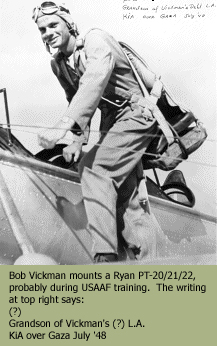 Bob
Vickman
Bob
Vickman Bob
Vickman
Bob
Vickman
Hollywood, California
Combat Record
KIA July 9, 1948
Story
Bob Vickman, like his friend Stan Andrews, flew for the USAAF in the southwest Pacific, although he flew an observer aircraft and not a fighter (Finkel, pers. comm.). He had flown 65 sorties by war's end.
After the war, he attended art school in Los Angeles with Andrews. They felt as Jews a desire to help Israel and as artists, they wanted to record visually the birth of the new state. They brought cameras and art supplies with them from California.
Part of the second wave of pilots to be trained in Czechoslovakia to use the S-199, Bob Vickman arrived in Israel in early June, probably June 5.
Shortly after arriving in Israel, the veteran pilots of the 101 took the new guys out to a Tel Aviv bar. The pilots discussed creating a logo for the squadron. Modi Alon wanted the logo to feature a scorpion, like a particular RAF squadron's badge. Mindful of their main foe, the Egyptians, Lenart remarked that it had been the angel of death who finally forced the biblical Pharoah to capitulate in the Passover story and suggested that theme.
![]() Andrews
and Vickman sketched out a first draft of an angel of death badge on a cocktail
napkin. They drew a skull wearing a flying helmet - the symbol that would soon
be painted on the left side of all the 101's birds. Modi Alon's scorpion design
was adopted by 105 Squadron in 1950.
Andrews
and Vickman sketched out a first draft of an angel of death badge on a cocktail
napkin. They drew a skull wearing a flying helmet - the symbol that would soon
be painted on the left side of all the 101's birds. Modi Alon's scorpion design
was adopted by 105 Squadron in 1950.
The 6'2" Vickman was to fly with the 101 for only a month - although in the tiny S-199 cockpit, each flight might have seemed that long to him. At dawn July 9, as part of the new Israeli offensive, Lou Lenart led Vickman and Bill Pomerantz from Herzliya into the air in bomb-laden S-199s. Stan Andrews had planned to be the fourth, but had an accident on take-off.
Lenart took off first, to be followed by Andrews. On take-off, Andrews slewed to the left and dug his right wingtip into the ground. The plane flipped and rested on its back. Ground crews tried to move the plane for 20 minutes while Lenart orbited the field. Finally, some local Yemenite farmers used long poles to right the plane. Vickman and Pomerantz then joined Lenart.
The detonators of the two bombs Andrews's plane had been carrying had not yet been set and the bombs did not explode. Andrews walked away from the wreck with minor head injuries.
Either the three airborne pilots could not find their intended target, Al Arish, due to heavy cloud, or Lenart was too low on fuel to make it all the way there, or both, but in any case they attacked a ship in Gaza harbor that appeared to be unloading troops and supplies. Lenart dove in a dive bombing and strafing attack with Vickman behind him, but when he pulled out, he couldn't find Vickman's plane. He returned to Herzliya and landed extremely low on fuel. Pomerantz had beaten Lenart back home.
Vickman did not return and the 101 believed, incorrectly, that he had been shot down by ground gunners.
An Egyptian account helps clear up Vickman's fate. As Vickman egressed, he spotted an REAF Lysander. Vickman couldn't have known that the Deputy Director General of the REAF, Air Commodore Abd al Moneim Mikaati, was flying that Lysander from Cairo to Al Arish. Mikaati recalled:
...My gunner - I don't remember his name - was a keen-sighted man and he spotted an Israeli Messerschmitt as it maneuvered into a position to attack. Of course, my Lysander was a very old kind of airplane but I'd flown these for a long time. Still, we were at a big disadvantage and you'd expect that such a contest could only end one way.
The pilot of the Israeli aircraft came up behind us. I told my gunner to fire just before the Messerschmitt came into range and I went down to about 100 feet. Then the gunner fired and I throttled right back. You know the Lysander can drop like a stone to land in a field - like they did when the RAF took spies in and out of France. The Israeli must have been concentrating on keeping me in his sights because he dropped his nose to follow. He overshot and went right in, almost level with me. I honestly felt sick in my stomach and - I don't know why - I saluted him. (Cull et al 1994)
Note that Mikaati does not say his gunner hit the plane.
A few days later, the 101 Squadron would discover that the S-199s' cowl machine guns were not synchronized with the propeller. It's possible that Vickman did not fly into the seathrough carelessness, but that upon strafing the port, he weakened his prop so much that it snapped in a high-speed dive on the Lysander. Vickman could also have shot his prop off while firing at the Lysander itself. Vickman, not a fighter pilot by training, could also have overestimated the S-199. He may have chased the low, slow Lysander in a power dive and not left himself enough altitude to pull out.
Vickman's death affected the emotions and careers of several colleagues. Stan Andrews and Dov Ben Zvi felt the blow particularly hard. According to Ben Zvi, Andrews began to "do stupid things" which would lead to his grounding and says the event started a path that led to his later nervous breakdown. Lou Lenart was shortly thereafter transferred to Air HQ.